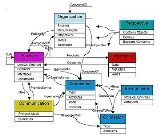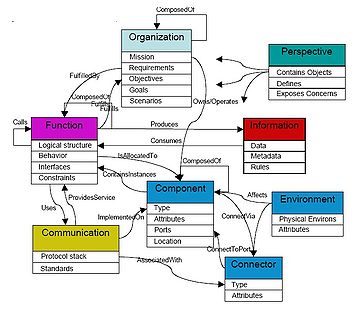
Military taxonomy
Encyclopedia
Military taxonomy encompasses the domains of weapons, equipment, organizations, strategies, and tactics. The use of taxonomies
in the military extends beyond its value as an indexing tool or record-keeping template.
 Military theorist Carl von Clausewitz
Military theorist Carl von Clausewitz
stressed the significance of grasping the fundamentals of any situation in the "blink of an eye" (coup d'œil
). In a military context, the astute tactician can immediately grasp a range of implications and can begin to anticipate plausible and appropriate courses of action. Clauzewitz' conceptual "blink" represents a tentative ontology
which organizes a set of concepts within a domain
.
A conventional military taxonomy might be an hierarchical set of classifications for a given set of objects; and the progress of reasoning is developed from the general to the more specific. In such taxonomic schema, a conflative term is always a polyseme.
In contrast, a less conventional approach might employ an open-ended contextual military taxonomy—a taxonomy holding only with respect to a specific context; and the progress of reasoning is developed form the specific to the more general.
.
In terms of a specific military operation, a taxonomic approach based on differentiation and categorization of the entities participating would produce results which were quite different from an approach based on functional objective of an operation (such as peacekeeping, disaster relief, or counter-terrorism). An incidental advantage which flows from give-and-take in refining taxonomic terms more accurately and efficiently becomes more than a worthwhile objective in terms of anticipated outcomes or results. In today's nontraditional operations, the discussion about fundamentals also generates greater precision in how the defense and security community understands and discusses integrated operations.
, which are ships of the Japan Maritime Self-Defense Force
(JMSDF).
This type of helicopter carrier
was formally identified as a helicopter destroyer
(DDH) to comply with explicit constitutional limitations written in Article 9 of the Japanese Constitution
.
The two ships of this class, the JS Hyūga and the JS Ise resemble a light aircraft carrier
or amphibious assault ship
such as the Italian Navy's 13,850-ton Giuseppe Garibaldi, the Spanish Navy
's 17,000-ton Principe de Asturias or the Royal Navy
's 21,000-ton Invincible-class carriers
. According to a PBS
documentary, JS Hyūga is the "first Japanese aircraft carrier built since WWII;" but this label is controversial. A taxonomic label of "aircraft carrier" is legally proscribed.
Each ship in this class has attracted media and Diet attention because of its resemblance to an aircraft carrier. Until the 1970s, US Navy taxonomy categorized large-scale flattops as "attack aircraft carriers" and small flattops as "antisubmarine aircraft carriers." In Japan, the constitutional prohibition against having "attack" aircraft carries has been construed to encompass small aircraft carriers but not helicopter carriers.
A uniquely Japanese taxonomic template is applied to these ships and to their missions, which are limited to "military operations other than war
" (MOOTW).
Taxonomies are a necessary but not sufficient condition for adequate evaluation of a given data set. While the taxonomic categorizations and sub-categorizations do enhance understanding, it may be significant that the lack of detail in describing objects or elements creates room for ambiguity.
Taxonomy
Taxonomy is the science of identifying and naming species, and arranging them into a classification. The field of taxonomy, sometimes referred to as "biological taxonomy", revolves around the description and use of taxonomic units, known as taxa...
in the military extends beyond its value as an indexing tool or record-keeping template.
Blink of an eye

Carl von Clausewitz
Carl Philipp Gottfried von Clausewitz was a Prussian soldier and German military theorist who stressed the moral and political aspects of war...
stressed the significance of grasping the fundamentals of any situation in the "blink of an eye" (coup d'œil
Coup d'œil
Coup d'œil is a term taken from French, that more or less corresponds to the words glimpse or glance in English. The literal meaning is "stroke of [the] eye"....
). In a military context, the astute tactician can immediately grasp a range of implications and can begin to anticipate plausible and appropriate courses of action. Clauzewitz' conceptual "blink" represents a tentative ontology
Ontology
Ontology is the philosophical study of the nature of being, existence or reality as such, as well as the basic categories of being and their relations...
which organizes a set of concepts within a domain
Domain of discourse
In the formal sciences, the domain of discourse, also called the universe of discourse , is the set of entities over which certain variables of interest in some formal treatment may range...
.
A conventional military taxonomy might be an hierarchical set of classifications for a given set of objects; and the progress of reasoning is developed from the general to the more specific. In such taxonomic schema, a conflative term is always a polyseme.
In contrast, a less conventional approach might employ an open-ended contextual military taxonomy—a taxonomy holding only with respect to a specific context; and the progress of reasoning is developed form the specific to the more general.
Descriptive paradigm
A taxonomy of terms to describe various types of military operations is fundamentally affected by the way all elements are defined and addressed—not unlike framingFraming (social sciences)
A frame in social theory consists of a schema of interpretation — that is, a collection of anecdotes and stereotypes—that individuals rely on to understand and respond to events. In simpler terms, people build a series of mental filters through biological and cultural influences. They use these...
.
In terms of a specific military operation, a taxonomic approach based on differentiation and categorization of the entities participating would produce results which were quite different from an approach based on functional objective of an operation (such as peacekeeping, disaster relief, or counter-terrorism). An incidental advantage which flows from give-and-take in refining taxonomic terms more accurately and efficiently becomes more than a worthwhile objective in terms of anticipated outcomes or results. In today's nontraditional operations, the discussion about fundamentals also generates greater precision in how the defense and security community understands and discusses integrated operations.
Hyūga class helicopter destroyer
Military taxonomy in Japan is circumscribed by Japan's pacifist post-war constitution. For example, this affects classification of the Hyūga class helicopter carriersHyuga class helicopter destroyer
The are a type of helicopter carrier being built for the Japan Maritime Self-Defense Force . Two ships of the class were built to replace the two 7,000-ton Haruna-class helicopter destroyers. The new ships are the largest combatant ship operated by Japan since the Imperial Japanese Navy was...
, which are ships of the Japan Maritime Self-Defense Force
Japan Maritime Self-Defense Force
The , or JMSDF, is the naval branch of the Japan Self-Defense Forces, tasked with the naval defense of Japan. It was formed following the dissolution of the Imperial Japanese Navy after World War II....
(JMSDF).
This type of helicopter carrier
Helicopter carrier
Helicopter carrier is a term for an aircraft carrier whose primary purpose is to operate helicopters. The term is sometimes used for both ASW carriers and amphibious assault ships....
was formally identified as a helicopter destroyer
Destroyer
In naval terminology, a destroyer is a fast and maneuverable yet long-endurance warship intended to escort larger vessels in a fleet, convoy or battle group and defend them against smaller, powerful, short-range attackers. Destroyers, originally called torpedo-boat destroyers in 1892, evolved from...
(DDH) to comply with explicit constitutional limitations written in Article 9 of the Japanese Constitution
Article 9 of the Japanese Constitution
Article 9 of the Japanese Constitution is a clause in the National Constitution of Japan that prohibits an act of war by the state. The Constitution came into effect on May 3, 1947, immediately following World War II. In its text, the state formally renounces war as a sovereign right and bans...
.
The two ships of this class, the JS Hyūga and the JS Ise resemble a light aircraft carrier
Aircraft carrier
An aircraft carrier is a warship designed with a primary mission of deploying and recovering aircraft, acting as a seagoing airbase. Aircraft carriers thus allow a naval force to project air power worldwide without having to depend on local bases for staging aircraft operations...
or amphibious assault ship
Amphibious assault ship
An amphibious assault ship is a type of amphibious warfare ship employed to land and support ground forces on enemy territory by an amphibious assault...
such as the Italian Navy's 13,850-ton Giuseppe Garibaldi, the Spanish Navy
Spanish Navy
The Spanish Navy is the maritime branch of the Spanish Armed Forces, one of the oldest active naval forces in the world. The Armada is responsible for notable achievements in world history such as the discovery of Americas, the first world circumnavigation, and the discovery of a maritime path...
's 17,000-ton Principe de Asturias or the Royal Navy
Royal Navy
The Royal Navy is the naval warfare service branch of the British Armed Forces. Founded in the 16th century, it is the oldest service branch and is known as the Senior Service...
's 21,000-ton Invincible-class carriers
Invincible class aircraft carrier
The Invincible class is a class of light aircraft carrier operated by the British Royal Navy. Three ships were constructed, , and . The vessels were built as aviation-capable anti-submarine warfare platforms to counter the Cold War North Atlantic Soviet submarine threat, and initially embarked...
. According to a PBS
Public Broadcasting Service
The Public Broadcasting Service is an American non-profit public broadcasting television network with 354 member TV stations in the United States which hold collective ownership. Its headquarters is in Arlington, Virginia....
documentary, JS Hyūga is the "first Japanese aircraft carrier built since WWII;" but this label is controversial. A taxonomic label of "aircraft carrier" is legally proscribed.
Each ship in this class has attracted media and Diet attention because of its resemblance to an aircraft carrier. Until the 1970s, US Navy taxonomy categorized large-scale flattops as "attack aircraft carriers" and small flattops as "antisubmarine aircraft carriers." In Japan, the constitutional prohibition against having "attack" aircraft carries has been construed to encompass small aircraft carriers but not helicopter carriers.
A uniquely Japanese taxonomic template is applied to these ships and to their missions, which are limited to "military operations other than war
Military operations other than war
Military Operations Other Than War focus on deterring war, resolving conflict, promoting peace, and supporting civil authorities in response to domestic crises. The phrase and acronym was coined by the United States military during the 1990s, but it has since fallen out of use. The UK military...
" (MOOTW).
Strategic paradigm
A number of military strategies can be parsed using a taxonomy model. The comparative theoretical framework might posit a range of criteria, e.g., the character of envisaged political goals, the type of military strategy preferred, and the scope of forces engaged; and this template suggests discrete modes of force. The taxonomy-model analysis suggests a useful depiction of the spectrum of the use of military force in a political context.Parsing terrorism
In the 21st century, the ambit of a subset taxonomy of terrorism would include terms related to terrorists, terrorist groups, terrorist attacks, weapons, venues, and characteristics of terrorists and terrorist groups.Limitations
Taxonomies offer useful, but incomplete means of structuring information.Taxonomies are a necessary but not sufficient condition for adequate evaluation of a given data set. While the taxonomic categorizations and sub-categorizations do enhance understanding, it may be significant that the lack of detail in describing objects or elements creates room for ambiguity.

